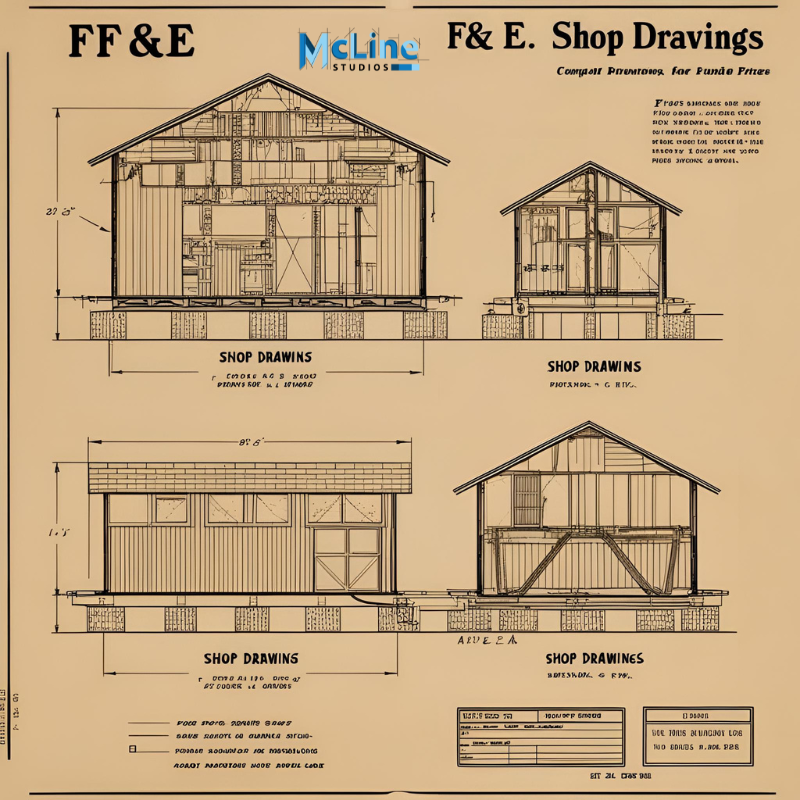Step-by-Step Guide to Creating Detailed FF&E Shop Drawings

Creating detailed FF&E (Furniture, Fixtures, and Equipment) shop drawings is a critical step in ensuring that interior design projects come to life exactly as envisioned. These drawings serve as precise blueprints that guide manufacturers, contractors, and installers in fabricating and placing every piece of furniture and equipment with accuracy.
Whether you’re a designer, drafter, or project manager, understanding how to develop comprehensive FF&E shop drawings can streamline communication, minimize errors, and keep your project on schedule and budget.
In this step-by-step guide, we’ll walk you through the essential stages of creating clear, accurate, and professional FF&E shop drawings that bring your designs from concept to reality.
Gathering Necessary Information
The first step in creating detailed FF&E shop drawings is gathering all the necessary information. This step is very important because good drawings depend on having the right details from the start. Without accurate information, mistakes can happen, which can cause delays and extra costs.
Begin by collecting the project’s design plans and specifications. These documents usually include floor plans, elevations, and design concepts that show where furniture, fixtures, and equipment should be placed. Understanding the overall design will help you know what kind of FF&E items you need to draw.
Next, get the exact measurements of the spaces where the FF&E will go. This means checking room sizes, wall heights, doorways, and any other important details like ceiling heights or window placements. Accurate measurements are key to making sure the furniture and equipment will fit perfectly.
You should also gather product details from the manufacturers or suppliers. This includes the size, shape, materials, finishes, and any special installation instructions. If you don’t have this information, the drawings might not match the actual products, causing confusion later.
Lastly, check the project timeline and budget. Knowing the deadlines and cost limits will help you prioritize which drawings need to be done first and ensure the design fits the budget.
Taking the time to gather complete and correct information at the beginning makes the rest of the drawing process smoother. It helps avoid costly errors and ensures the final FF&E shop drawings are accurate and reliable.
Setting Your Drawing Workspace
Once you have all the needed information, the next step is to set up your drawing workspace. This is where you will create the FF&E shop drawings. A clean and well-organized workspace helps you work faster and make fewer mistakes.
Start by choosing the right software for drafting. AutoCAD, Revit, or other CAD programs are commonly used for creating shop drawings. Make sure the software is installed correctly and updated to the latest version. If you’re using templates or drawing standards, load them into your project before you begin.
Set up the correct units of measurement—like millimeters or inches—depending on the project requirement. Use proper layers to organize different parts of the drawing, such as furniture, electrical points, or notes. Naming your layers clearly helps keep your work neat and easy to understand.
Prepare your title block with project name, drawing number, date, scale, and other basic details. This makes your drawing look professional and keeps all information in one place.
Check your computer monitor resolution and workspace lighting. A bright and clear screen helps you see small details better. Also, keep your desk space tidy, with easy access to your notes, samples, or sketches.
Finally, save your project in a secure folder with regular backups. Losing your work due to errors or power cuts can waste hours of effort.
By setting up your workspace properly, you’ll be ready to create clear, accurate, and professional FF&E shop drawings from the very beginning.
Developing the Base Plan
After setting up your drawing workspace, the next important step is developing the base plan. The base plan is the foundation of your FF&E shop drawings. It shows the layout of the space where the furniture, fixtures, and equipment will be placed.
Start by importing or tracing the architectural floor plan into your drawing file. Make sure the plan is to scale and aligned correctly. The base plan should include walls, windows, doors, columns, and other fixed elements. These help you understand where each FF&E item will go and how much space is available.
It’s also important to include room names, dimensions, and levels if needed. Labeling each area clearly helps everyone know which room they are looking at and where items belong. You can also add ceiling heights and floor finishes if they affect the placement of any furniture or equipment.
Use clean lines and the correct layers for different elements. For example, walls should be on one layer, doors on another, and notes on a separate layer. This keeps your drawing organized and easy to edit later.
Double-check your measurements against the original design plans to avoid mistakes. Even a small error in the base plan can lead to bigger problems in later stages.
Once your base plan is ready, save it as a reference file. You will use it to place and detail all FF&E items accurately.
Creating a strong base plan helps you build the rest of the FF&E drawings smoothly and with confidence.
Detailing FF&E Components
FF&E stands for Furniture, Fixtures, and Equipment. These are important parts of any interior space, whether it’s a home, office, hotel, or hospital. FF&E items are not part of the building’s structure but are essential for the function and feel of the space.
Detailing FF&E components means creating clear and accurate drawings or documents that show exactly what each item is, how it looks, and where it will go. This includes things like chairs, desks, beds, shelves, lighting, and even kitchen equipment.
Each FF&E detail usually includes the size, material, color, finish, and product brand or model. For example, a drawing of a chair would show its height, width, material (like wood or metal), fabric type, and color. These details help designers, contractors, and clients understand what will be used in the space.
Clear FF&E detailing ensures smooth coordination during the project. It helps avoid mistakes, keeps costs under control, and makes sure everything fits well in the space. It also helps with ordering the right items at the right time.
In large projects, FF&E schedules are used. These are simple tables that list every item along with details like quantity, code, and delivery time. This makes it easier to manage many items.
Dimensioning and Annotations
Dimensioning and annotations are very important in architectural and engineering drawings. They give clear information about the size, location, and details of different elements in a design. Without them, it would be hard for builders, carpenters, and other workers to understand how to build or install things correctly.
Dimensioning means adding measurements to a drawing. These measurements show lengths, widths, heights, and distances between objects. For example, in a floor plan, dimensions tell how long a wall is or how far a door is from the corner. These numbers are usually shown in millimeters or inches, depending on the country.
Good dimensioning is clear, neat, and easy to read. It should not crowd the drawing or make it confusing. Only the most necessary dimensions are added so the design is not overloaded with information.
Annotations are short notes or labels added to drawings. They give extra information that dimensions cannot show. Annotations may describe materials, finishes, item names, or instructions. For example, a note may say “wood finish,” “painted wall,” or “fix with screws.” These notes help everyone understand the design better.
Together, dimensioning and annotations make a drawing complete and useful. They help avoid mistakes, reduce delays, and improve communication between designers, clients, and construction teams.
The End Note
Creating detailed FF&E shop drawings is a crucial part of turning design concepts into reality. By following a structured, step-by-step approachfrom gathering accurate project information to setting up your workspace, developing a reliable base plan, and carefully detailing components, you ensure that every piece of furniture, fixture, and equipment is represented accurately. Adding proper dimensions and annotations further enhances clarity, helping avoid costly mistakes and miscommunication.
These drawings not only guide manufacturers and installers but also serve as a vital communication tool between designers, contractors, and clients. Investing time and effort into producing high-quality FF&E shop drawings ultimately leads to smoother project execution, better coordination, and successful design outcomes that meet both aesthetic and functional goals.
- Art
- Causes
- Crafts
- Dance
- Drinks
- Film
- Fitness
- Food
- Oyunlar
- Gardening
- Health
- Home
- Literature
- Music
- Networking
- Other
- Party
- Religion
- Shopping
- Sports
- Theater
- Wellness




